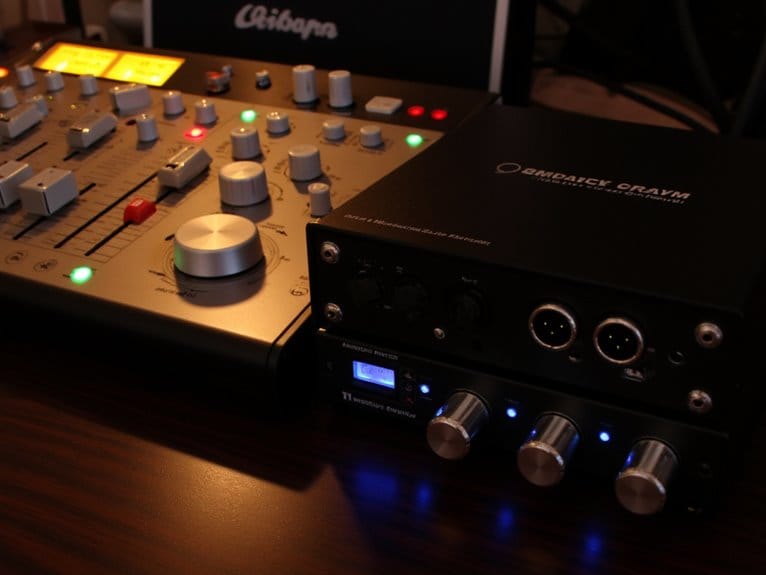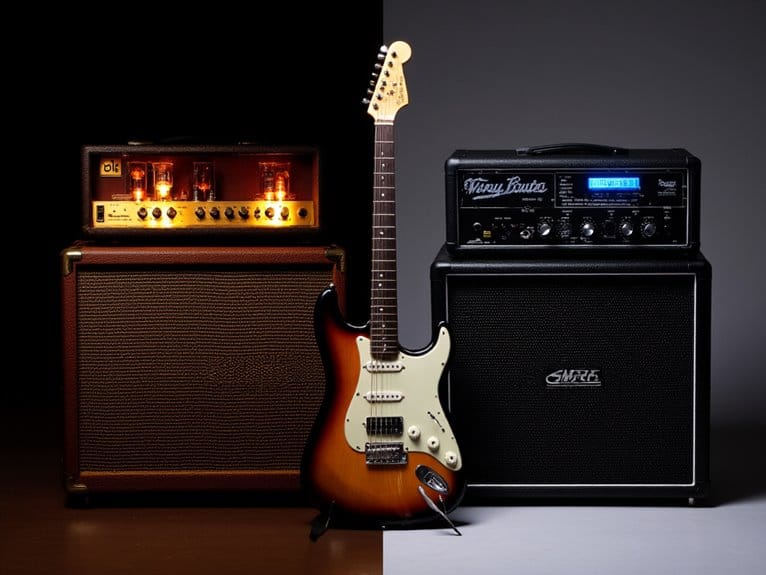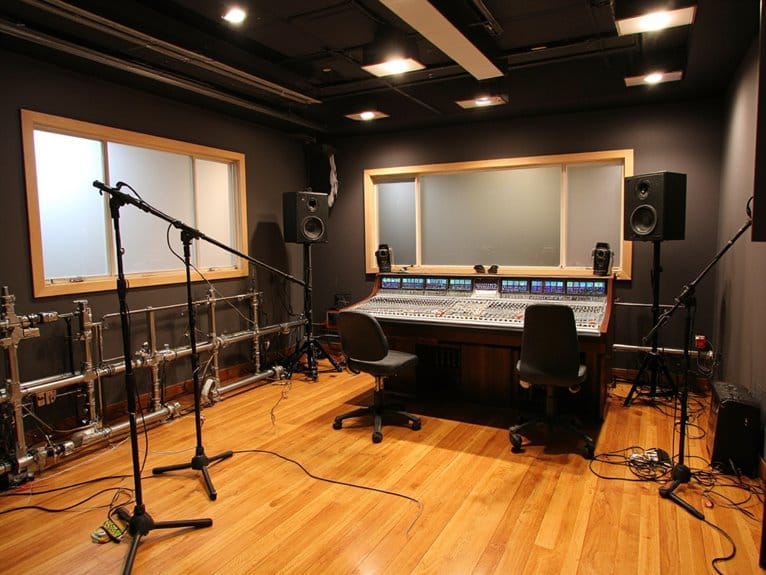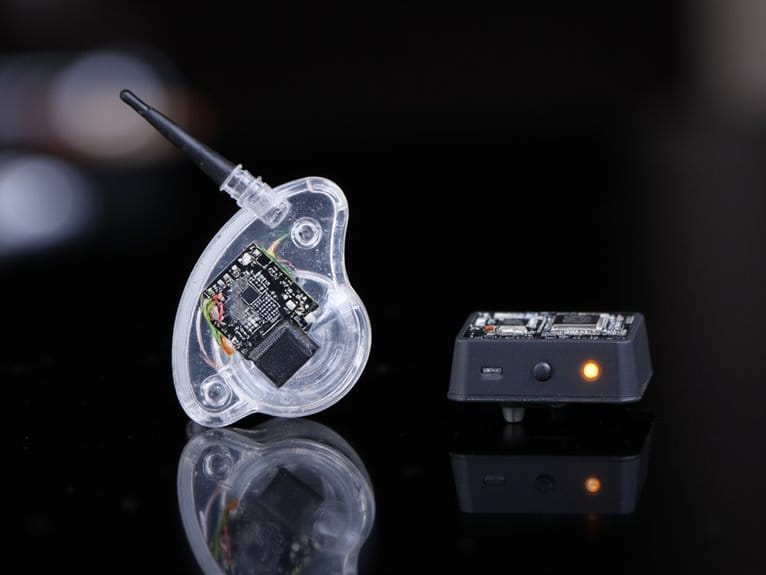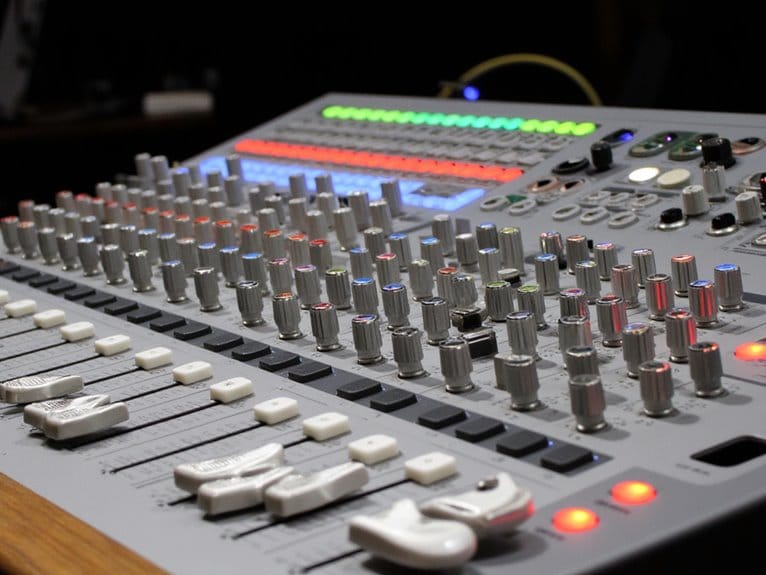Mixer Vs Audio Interface: Which Do You Need
You’ll need an audio interface if you’re focused on studio recording, as they excel at converting analog signals to digital with superior sound quality and seamless DAW integration, typically offering 2-4 inputs with USB connectivity. However, if you’re performing live or need real-time control over multiple sources, mixers provide 8-32 channels with hands-on knobs and sliders for immediate adjustments without software dependency. The insights below reveal which scenarios favor each device’s strengths.
We are supported by our audience. When you purchase through links on our site, we may earn an affiliate commission, at no extra cost for you. Learn more.
Notable Insights
- Audio interfaces excel at recording into DAWs with superior digital conversion, while mixers provide real-time control for live performances.
- Mixers offer more input channels (8-32) for full bands, whereas audio interfaces typically max out at 4 channels for solo musicians.
- Choose mixers for live events requiring immediate tactile control; select audio interfaces for home studio recording into computer software.
- Audio interfaces deliver higher sound quality and cost efficiency for basic recording needs compared to built-in sound cards.
- Combination mixer/audio interface units provide budget-friendly solutions for users needing both recording capabilities and live mixing control.
Core Functionality and Purpose Differences
While both audio interfaces and mixers handle audio signals, they serve fundamentally different purposes that I’ve observed can confuse newcomers to audio production.
Your audio interface acts as a digital translator, converting analog signals into digital data that your computer can process, then converting it back for playbook through monitors or headphones.
In contrast, your mixer functions as a real-time signal processing hub, combining multiple audio sources and letting you adjust levels, EQ, and effects on the fly.
I’ve found that interfaces excel at workflow optimization for recording projects since they integrate seamlessly with DAWs, while mixers shine in live situations where you need immediate, hands-on control without relying on software processing power. Audio interfaces typically provide superior sound quality compared to your computer’s built-in sound card, making them essential for professional recording applications.
Many professional audio interfaces support 24-bit/192kHz resolution, ensuring superior audio fidelity and minimal noise during recordings.
USB audio interfaces represent the most common type and connect directly via USB with limited inputs and outputs, making them particularly suitable for laptop recording setups. Both options often include essential features like phantom power for condenser microphones and zero-latency monitoring capabilities.
Input Capacity and Connection Options by
Beyond these fundamental operational differences, the question of how many audio sources you can connect simultaneously becomes the deciding factor for most users, and I’ve learned this often determines whether you’ll end up frustrated or satisfied with your choice.
When examining input versatility, mixers consistently offer more channels, typically ranging from eight to thirty-two inputs, while audio interfaces usually max out at four channels for consumer models.
The connection types also differ greatly, with mixers providing multiple XLR and TRS inputs for microphones and instruments, whereas interfaces focus on USB connectivity for computer integration.
If you’re recording a full band, you’ll need that mixer’s expanded input capacity, but solo musicians often find interfaces perfectly adequate for their streamlined setups. Many professional mixers also include phantom power capabilities, which are essential for powering condenser microphones during live performances and studio recordings. Audio interfaces can be expanded through ADAT connectivity to accommodate additional input options when needed.
Audio interfaces typically feature Thunderbolt or USB outputs for connecting to computers, providing reliable digital connections for modern recording setups.
Professional mixers like the Yamaha TF1 can provide up to 40 input channels with motor faders for precise control in larger production environments.
Control Methods and Real-Time Features
Nothing quite compares to the tactile satisfaction of adjusting a physical fader during a live performance, and I’ve discovered this fundamental difference in control methods often determines which device you’ll reach for when the pressure’s on.
Mixers excel with hands-on control interfaces, featuring dedicated knobs, sliders, and buttons that let you make instant adjustments without looking away from your performance. Audio mixers provide low latency for real-time audio processing, making them particularly responsive during live situations.
Audio interfaces, however, rely on software-based control systems that require computer interaction, which frankly isn’t ideal when you’re managing performance dynamics in real time. Audio interfaces primarily focus on digital sound conversion rather than providing extensive mixing capabilities.
While interfaces work beautifully for studio recording where you can take your time tweaking settings, mixers provide the immediate feedback and precision control that live environments demand, allowing you to respond instantly to acoustic changes.
Best Use Cases for Each Device Type
Your recording environment and performance requirements ultimately dictate whether you’ll need the hands-on mixing capabilities of a dedicated mixer or the streamlined recording efficiency of an audio interface.
For live performances, you’ll find mixers indispensable since they provide real-time control over multiple audio sources, onboard effects processing, and the tactile feedback that performing musicians require.
Conversely, audio interfaces excel in home studio environments where you’re focused on capturing high-quality recordings directly into your DAW, making them perfect for podcast production and simple recording sessions.
Complex recording sessions involving multiple microphones often benefit from mixers’ multi-channel handling, while solo artists typically prefer audio interfaces for their compact design and seamless computer integration. Professional audio quality demands proper specifications including a signal-to-noise ratio above +90 dB for optimal recording clarity.
For streaming applications specifically, mixers with XLR connectivity and phantom power capabilities provide professional microphone support essential for content creators who need real-time voice effects and customizable sound control.
Audio Quality and Budget Factors
Two critical factors ultimately determine which device will serve your needs best: the audio quality you can achieve and the budget you’re working within.
Audio interfaces excel in audio clarity through superior analog-to-digital conversion, supporting higher sample rates and bit depths while minimizing noise interference through streamlined cable management. They’re typically more cost-efficient for basic recording, offering compact designs that reduce studio space requirements and integrate seamlessly with software-based mixing tools. Look for interfaces with 24-bit/192kHz resolution to ensure professional-grade audio fidelity for your recordings.
Mixers provide excellent analog signal blending and hands-on control but come with higher initial costs due to their complex designs and multiple built-in features. While mixers justify their expense through durability and onboard effects that eliminate external processor needs, interfaces offer better upgrade paths and cost efficiency for digital-focused workflows. For recording sessions with extensive input requirements, combination mixer/audio interface units are emerging as cost-effective solutions that provide the benefits of both devices. Many modern interfaces feature visual Gain Halos that indicate recording levels, helping prevent distortion and ensuring optimal signal capture.
Frequently Asked Questions
Can I Use Both a Mixer and Audio Interface Together Simultaneously?
You can absolutely use both devices together, and I’ve found that mixer compatibility with audio interfaces actually enhances your setup considerably.
The key to successful audio interface integration lies in using ASIO4ALL drivers, which bridge different devices seamlessly.
You’ll want to match buffer sizes across both units to minimize latency issues, but once configured properly, this combination gives you the hands-on control of a mixer plus high-quality digital recording capabilities.
Do I Need Special Drivers or Software to Operate These Devices?
Driver compatibility varies considerably between these devices, though software requirements depend on your specific setup and operating system.
You’ll typically need ASIO drivers for audio interfaces on Windows, while macOS often works plug-and-play, though I’ve found manufacturer drivers usually deliver better performance and lower latency.
Traditional analog mixers require no drivers, but digital mixers with USB connectivity need specific software for computer integration.
Which Device Offers Better Longevity and Upgrade Potential Over Time?
When considering longevity factors, mixers typically outlast audio interfaces since they rely less on software updates and feature robust analog components that resist obsolescence.
However, audio interfaces offer superior upgrade paths through regular driver updates, firmware improvements, and software compatibility enhancements.
You’ll find mixers provide stable, long-term performance with minimal maintenance requirements, while interfaces adapt better to evolving digital standards and connectivity options.
On a final note
You’ll need to weigh your specific recording goals, budget constraints, and workflow preferences when choosing between these devices. If you’re tracking multiple musicians simultaneously with real-time monitoring requirements, a mixer’s your best bet. However, if you’re focused on high-quality digital recording with computer integration, an audio interface delivers superior results. I’ve found that understanding your primary use case, rather than chasing features you won’t actually need, leads to better purchasing decisions.

